
Crown & Bridges
Crowns are dental restorations that completely cap or encircle a tooth to improve the strength or appearance of the tooth. A Bridge is a dental restoration used to replace a missing tooth or teeth by permanently joining (utilizing crowns) to the teeth adjacent to the toothless area.
Teeth need to be restored with a crown for the following reasons:
- Over implants
- Following root canal therapy
- For fabrication of bridges
- Aesthetics
WHO IS THIS TREATMENT FOR?
Crown and Bridges are recommended to patients for various reasons, like:
- Protect a root canal treated tooth
- Hold a dental bridge in place
- Cover severely discolored teeth
- Cover a dental implant
- Make a cosmetic modification etc
PRE-TREATMENT PREPARATION
A detailed consultation should be done with the dentist to understand the importance of a fixed crown (cap) which eventually strengthens your damaged tooth serving the following benefits:-
- Improves the aesthetics of your smile
- Returns broken teeth their natural chewing function capabilities
- Conceals previous procedures including fillings, implants, root canals, etc.
X-ray is advised to aid in more detailed and precise treatment planning.
Find out the various types of dental crowns and which one will be best suited for your teeth. After your all questions are answered the dentist can start the procedure.
PROCEDURE
Placing a permanent dental crown typically takes 2 dental office visits.
First visit:-
Your dentist will anesthetize (numb) the tooth and surrounding gum tissue and then shape the biting surface and sides of the tooth. Impression of the prepared tooth and jaw, as well as the opposite jaw, is taken. If the tooth is very decayed or otherwise too small to hold the crown, the dentist may "build up" the tooth to hold the crown. The dentist will also determine the shade of porcelain to match the surrounding teeth. During this 1st office visit, the dentist will make a temporary crown to cover the prepared tooth until the permanent one is ready. The temporary crown is held in place using temporary cement.
Second visit:-
Your dentist will remove the temporary crown and check the fit and color of the permanent crown. If everything is correct, then the dentist will fix the permanent crown with the cement.
POST-TREATMENT CARE
While a crowned tooth does not require any special care, remember that simply because a tooth is crowned does not mean the tooth is protected from decay or gum disease.
Therefore:-
- Maintain your oral hygiene by regular brushing twice a day, flossing daily, especially around the crown area where the gum meets the tooth.
- Rinsing with an antibacterial mouthwash at least once a day.
- See your dentist regularly.
- Avoid chewing hard or sticky foods, chewing ice, biting fingernails, and using your teeth to open packaging which may cause your crown to break or become loose.
Book Your Appointment

